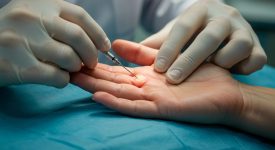
Needle Aponeurotomy for Dupuytren’s Disease: A Minimally Invasive Option
Needle Aponeurotomy for Dupuytren’s Disease: A Minimally Invasive Option
Introduction for Needle Aponeurotomy
For patients seeking fast recovery and minimal downtime, needle aponeurotomy (PNA)—also known as percutaneous needle fasciotomy—offers a safe and effective alternative to traditional surgery. Performed in a doctor’s office, this minimally invasive procedure can restore finger motion without the need for general anesthesia or surgical incisions, making it an appealing choice for those with early to moderate Dupuytren’s contracture.
How It Works
During the procedure, the physician uses a fine needle to puncture and weaken the fibrous cords beneath the skin that cause finger bending. As these cords loosen, the affected finger can be gently straightened. Unlike open surgery, there are no stitches or hospital stays, and most patients resume light activities within just a few days.
Research published in PubMed Central confirms the effectiveness of PNA for mild to moderate contractures, particularly at the metacarpophalangeal (MCP) joints, where results tend to be most durable.
Benefits
- Quick recovery: Most patients return to daily tasks within days.
- Low cost: The procedure is performed in-office without anesthesia or hospital fees.
- Minimal scarring: Tiny punctures replace large surgical incisions.
- Repeatable: The procedure can be done again if cords reform later.
Many specialists recommend combining PNA with hand therapy and night extension splints to maintain finger extension and minimize recurrence.
Risks and Limitations
While PNA is generally safe, it’s not without limitations. Recurrence can occur in up to 50–60% of cases within five years—especially among younger patients or those with aggressive forms of the disease. Minor risks include nerve irritation, bruising, or small skin tears, though these are rare when the procedure is performed by experienced clinicians.
Comparative studies in The Journal of Hand Surgery have shown that recurrence rates are similar to those seen with collagenase injections (Xiaflex) but higher than with open fasciectomy, which removes more diseased tissue.
Recovery and Aftercare
After PNA, most patients begin therapy immediately. A hand therapist typically provides splints, gentle range-of-motion exercises, and massage to restore flexibility and prevent stiffness. It’s important to avoid heavy gripping or strain for 1–2 weeks.
Lifestyle choices play a key role in long-term success—following a healthy, anti-inflammatory diet and maintaining stable blood sugar levels can help slow recurrence.
What the Science Says
Clinical studies have shown high satisfaction rates and significant functional improvement after PNA, especially in early-stage contractures. Long-term outcomes depend largely on ongoing therapy and systemic health. Conditions such as diabetes, thyroid imbalance, and chronic alcohol use can accelerate fibrosis, so managing these factors is essential.
Leading authorities like the American Society for Surgery of the Hand and the Mayo Clinic recommend post-procedure therapy as a crucial step for maintaining finger mobility and preventing contracture return.
Connections to Dupuytren’s and Related Conditions
Needle aponeurotomy provides a valuable middle ground between observation and surgery. It’s ideal for patients who want results without extended downtime. Those with related fibrotic conditions—such as Ledderhose disease (plantar fibromatosis) or frozen shoulder—may also benefit from addressing systemic inflammation that drives collagen buildup.
Key Takeaways
- Minimally invasive: Restores finger extension without major surgery.
- Rapid recovery: Most patients resume daily activities within days.
- Cost-effective and repeatable: Convenient in-office treatment.
- Therapy matters: Splinting and rehabilitation help prevent recurrence.
- Lifestyle support: Managing inflammation and overall health improves long-term outcomes.
Needle aponeurotomy represents progress in Dupuytren’s care—offering freedom of motion, faster healing, and the flexibility to manage recurrence effectively when it appears.
Attribution
(CC BY 4.0): Adapted from Foucher G, Medina J, et al. Needle Aponeurotomy in Dupuytren’s Contracture: Outcomes and Indications. Hand Surg Rehabil. 2016; 35(5): 311–318. Licensed under Creative Commons Attribution 4.0. For the complete article and reference list, click Source.
Call to Action
Connect with our Dupuytren’s community for support and real-world tips: Facebook Group.
Discover my journey and all treatments — conventional, alternative, root-cause therapies, and remission strategies — at DupuytrensSolutions.com.


